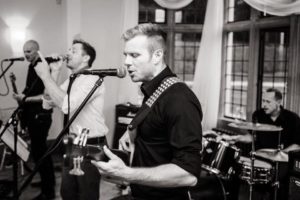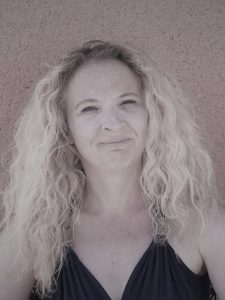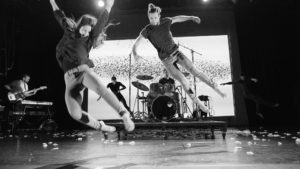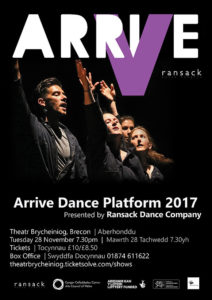Ransack Dance are about to tour their production ‘ Murmur’ Checkout this interview with Sarah Rogers, Artistic Director of Ransack Dance from last year. The 2019 tour dates are below.
The Hafren, Newtown 28 September Tickets
Aberystwyth Arts Centre, Aberystwyth 02 October Tickets
Maesteg Town Hall, Maesteg 11 October Tickets
Theatr Brycheiniog, Brecon 18 October Tickets
The Director of Get the Chance, Guy O’Donnell recently met with Sarah Rogers, Artistic Director of Ransack Dance, they discussed her background, thoughts on the arts in Wales and her new production ‘Murmur’, taking place on Fri 14th Sept at Memo Arts Centre, Barry.
Hi Sarah great to meet you, can you give our readers some background information on yourself please?
Hi I am a South Wales based dance artist, currently running my own dance company based in Pontypridd called Ransack Dance Company which I set up in 2013. Our work always involves live dance, music and film, and I choreograph and direct the work as the Artistic Director of the company, working collaboratively with the artists in each discipline. We are also Affiliate Company to Artis Community, working to support and develop their dance pathways provision in RCT and Merthyr. Alongside my work with Ransack and Artis, I also work as a freelance choreographer and dance teacher and am currently a Dance Ambassador for National Dance Company Wales.
So what got you interested in performance and the arts?
I’d love to tell you about an amazing theatre show that inspired me years ago but I must admit I don’t think this is the case as I didn’t really go to the theatre much as a child, but my pathway was definitely through a love to move and dance…… I trained as a gymnast from an early age, and I think my way into the arts is that I became more and more fascinated by the choreography of the floor routines opposed to the acrobatic elements, so I started choreographing my own and the other gymnasts routines at the club. My parents then cottoned onto the fact I may like to dance and I was very lucky as they were really supportive and so they started to take me to the theatre. I think the musical Cats stands out as one of the first shows that I saw and that inspired me as a child (weird as I’m really not into musicals now!). When I got older I joined a local street dance and break dance group which was led by Tamsin Fitzgerald (now Director of 2Faced Dance) so I was very lucky to have her as a teacher.
Tamsin Fitzgerald, Director of 2Faced Dance.
She pointed me in the right direction of what contemporary companies to go and see, so I started to watch more contemporary dance theatre work and loved it! And she also suggested I go to my local dance school to take more formal lessons in styles such as ballet, and from there I went onto study at Laban, and have never looked back!
Your company Ransack is presenting a new production called Murmur at Barry Memo on Friday 14 September 2018 at 7:30pm. The production is advertised as “Telling two unique short stories in a surge of risk taking athletic contemporary dance, crashing live music and breath taking film images.” It sounds very exciting! Can you tell us more?
‘Murmur’ is a double bill involving our work ‘Momenta’ and ‘Broken Arrows.’ We have been building the work through various R&D phases over the past three years, one of which included sharing an earlier version of Momenta at the Memo last November. We are excited now to go back to the Memo and share the finished work and perform ‘Broken Arrows’ which we have never performed at the venue before.
https://vimeo.com/285362800
Each work has live dance, music and film. The performers take the audience through a series of scenarios, dancing under feathers falling from the sky, jumping over drum kits, dancing at live gigs and fighting their way through storms! The first piece ‘Momenta’ is based on a television interview (from the 1973 Dick Cavett Show) with Marlon Brando in which he describes ‘We act every day to save our lives,’ so we explore this notion of acting as a survival mechanism and question in the piece-when are we truly authentic?
The second work ‘Broken Arrows’ is essentially a love story, and we reveal the memories of the protagonist character ‘The girl in red’, with some audiences seeing the work as presenting the theme of a love triangle and other seeing a more sinister side to the story.
https://vimeo.com/249021626
There’s another element to the production as we’re creating an immersive feel with our second work with performances from Motion Control Dance and University of South Wales intertwined to bring the work to life and immerse the audience in the action! We are also collaborating with a live band-‘Best Supporting Actors’ who will play live with the Ransack musicians in one of the works and also play in the interval and offer a free gig following the performance.
As you mention the production will be followed by a live gig from the band ‘Best Supporting Actors,’ Its unusual two mix these two artforms together why have you chosen to programme them together?
 It’s funny you say that as I think live music and dance is the most natural combination in the world!…Our work always involves live music, so by collaborating with the band we are trying to take this element to the next level. I think the initial idea came about as one of our scenes in ‘Broken Arrows’ is set at a music gig….so I wanted to actually have a full live band playing to bring this scene into reality, so the performers and the audience could actually be at a gig rather than recreating this somehow with just two musicians. There’s also another idea behind the collaboration however, as I’m really keen to create a full ‘night out’ experience for the audience, so that they can stay after the dance elements of the production, listen to some live music and have a drink so that we can challenge what the idea of going to see a dance show is. The performers will also be at the gig with the audience (turning into audience themselves!) and so I’m also hoping that this merges the idea of performers vs audience as two separate groups and allows the audience to get to know the performers and talk to them in a really relaxed environment (rather than a formal post show discussion for example).
It’s funny you say that as I think live music and dance is the most natural combination in the world!…Our work always involves live music, so by collaborating with the band we are trying to take this element to the next level. I think the initial idea came about as one of our scenes in ‘Broken Arrows’ is set at a music gig….so I wanted to actually have a full live band playing to bring this scene into reality, so the performers and the audience could actually be at a gig rather than recreating this somehow with just two musicians. There’s also another idea behind the collaboration however, as I’m really keen to create a full ‘night out’ experience for the audience, so that they can stay after the dance elements of the production, listen to some live music and have a drink so that we can challenge what the idea of going to see a dance show is. The performers will also be at the gig with the audience (turning into audience themselves!) and so I’m also hoping that this merges the idea of performers vs audience as two separate groups and allows the audience to get to know the performers and talk to them in a really relaxed environment (rather than a formal post show discussion for example).
Contemporary Dance can be thought of as an elitist art form, as a young Wales based dancer what work do you think needs to be done to support new audiences?
I think the majority of new audience come from outreach work, and working with young people to introduce them to dance…..This is a tough one as ultimately I think a lot of this issue comes down to what finding is available to allow dance companies to offer their outreach work for free or a reasonable and accessible price. Through my work with Artis Community in RCT, I see the challenge first hand of taking dance provision out of cities such as Cardiff.
Participation numbers are lower (at the moment!) travel sometimes becomes an issue as areas are more spread out, and there are more areas of deprivation in which organisations simply can not charge a lot (or anything) for dance classes if we want all young people to be able to access them.
I think there’s another side to this too however, which is really thinking about what new audiences to dance need. A lot of them want to be able to ‘understand’ the work, which we all know that the response from someone in the dance world (including myself!) would be ‘but there is nothing to understand ….and you can take what you want from it’. But I’m finding out more and more that even though we can preach this it won’t change how some audiences think. So I think it’s finding a way to share the process of work more and share what work is about before the audience sees it. This is already happening through lots of companies opening up their rehearsals and using social media more to share the process behind making the works, so I think just developing this and growing this idea in different ways would be great. I also think including other art forms helps, and this is part of the reason that with Ransack we include film and music as some audiences may relate to these art forms more than the dance at first and be able to use this as ‘a way in’ to the dance elements.
Get the Chance works to support a diverse range of members of the public to access cultural provision. Access for diverse citizens is a key priority for a range of arts funders and organisations Are you aware of any barriers to equality and diversity for either Welsh or Wales based artists/creatives?
I think the main barrier is economic. There are very few schools that offer a dance G.C.S.E or A Level for example with young people then having to pay for extra-curricular provision in dance at dance schools which often charge a lot for their classes, and some families simply can not afford this. There’s then also issues over funding for organisations and companies to be able to offer their dance provision for an accessible price so that people from all backgrounds can access their provision.
There are a range of organisations supporting Welsh and Wales based artists and creatives, I wonder if you feel the current support network and career opportunities feel ‘healthy’ to you?
Part of the reason I moved back to Wales is that I do feel like there is a really supportive arts network here, particularly in dance. It’s great that there are now professional dance classes available through Groundwork Pro too.
I would say that I think there could be more support for emerging choreographers however and emerging companies. One of my reactions to this was to set up the Arrive Dance Platform for emerging choreographers with Ransack and share our theatre space when we have R&D with other artists so they can platform their work and get feedback. I think however that perhaps some of the bigger companies and organisations could support this area a bit more, particularly with the loss of Wales Dance Platform a few years ago.
If you were able to fund an area of the arts in Wales what would this be and why?
That’s such a hard question to answer! I think that all areas of the arts from community practice, to youth provision to professional production work and in all art forms support and feed into one another so I couldn’t pick just one! I think where the arts can thrive is when each area supports each other and all artists and organisations collaborate and work together.
What excites you about the arts in Wales?
I think there’s a really exciting feel in Wales that art forms merge from one to another. There’s lots of multi-media/multi-art form work happening. In my dance world I’ve seen this more and more through actors working with dancers and vice versa and this is one of the reasons my work is merging more and more into physical theatre, involving speech in our work (after having collaborated with Theatre Director Angharad Lee). Although I love the arts scene in Cardiff, it’s also exciting to see more and more artists coming out of the capital city and setting up their own networks and connections, and to see how these areas are evolving culturally because of this. This is one of the reasons that this year I have decided to base Ransack in Pontypridd, and with the new theatre and training spaces opening here at the YMCA next year, there have been lots of artists interested in working in this area, and there’s been lots of interesting and creative planning meetings and conversations happening that I’ve been involved in, so it’s exciting that we can start a new network and way of working together in the area.
What was the last really great thing that you experienced that you would like to share with our readers?
There’s a couple I think that stand out in my mind from recently….I’ve seen a couple of great shows lately, one was out of Wales in London at Sadlers Wells-Hofesh Shechter’s ‘Grande Finale,’ which I would recommend.
Again the mixture of live dance and music in this show really inspires me.
In Wales, most recently I have seen National Theatre Wales’ ‘English,’ which I loved as it really closed the gap between the audience and the performer and the way that the show instigated a conversation between the two was really clever and something I’d like to take into my own work. Oh and it was a little while ago but their production ‘We’re Still Here’ also really inspired me, particularly the way the community stories and people from the community were integrated into the performance.
NTW We’re Still Here
Thanks for your time Sarah.










